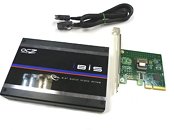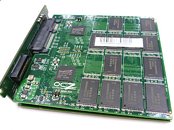Wednesday, October 20th 2010

OCZ IBIS HSDL Solid State Drive Dissected
The High Speed Data Link (HSDL) interface, designed by OCZ as an alternative to SATA and SAS, for high data-rate and high I/O solid-state drives (SSD) in an enterprise environment, gained quite some attention. Funky Kit scored a sample, and got the chance to dissect OCZ's first SSD that makes use of the HSDL interface, the IBIS 160 GB. OCZ also found a novel way to propagate HSDL, by bundling a single-port PCI-Express x4 addon card. Upon taking apart the card, one can understand exactly how it works. Under the hood, there are two main PCBs, one that houses a HSDL-based 2-port SATA RAID controller, and the other, which holds two independent SandForce-driven SATA SSD sub-units.
Two two SSD sub-units are striped in an internal RAID 0, which is kept abstract to the host. The HSDL itself is technically very similar to PCI-Express, in being a point-to-point serial data link. The IBIS SSD is rated to have read-write speeds of 740 MB/s and 690 MB/s, respectively, with 4KB random write performance of 100,000 IOPS. The drive connects to its host PCI-E addon card over a proprietary-design cable, while retains the SATA power connector input of conventional SATA devices. The drive itself adheres to the 3.5" PC form-factor. More pictures can be found at the source.
Source:
Funky Kit
Two two SSD sub-units are striped in an internal RAID 0, which is kept abstract to the host. The HSDL itself is technically very similar to PCI-Express, in being a point-to-point serial data link. The IBIS SSD is rated to have read-write speeds of 740 MB/s and 690 MB/s, respectively, with 4KB random write performance of 100,000 IOPS. The drive connects to its host PCI-E addon card over a proprietary-design cable, while retains the SATA power connector input of conventional SATA devices. The drive itself adheres to the 3.5" PC form-factor. More pictures can be found at the source.





17 Comments on OCZ IBIS HSDL Solid State Drive Dissected
IMO this idea/design from OCZ is clutching at straws. Creating a proprietary new interface that is faster than SATA 300 but has *just one connector* is just silly. At the end of the day, we are interested in improved real-world speed which is more along the lines of the IOPs and 4K read/writes rates, and NOT just the max sustained single block read rates.
This extra interface card? What an environmental waste of money and silicon. FAR BETTER to redirect those resources to bump up the on board RAID cache sizes. Or RAID 4 smaller SSDs rather than 2 bigger ones. Or fill those four missing ram chips on the pcb.
But, unfortunately, 740MB/s and 100,000 IOPs "sells better" than 300MB/s and 200,000 IOPs
www.anandtech.com/show/3949/oczs-fastest-ssd-the-ibis-and-hsdl-interface-reviewed
btw its good move from ocz and i hope motherboard manufacture can include these interface
Something we JUST DON'T SEE anymore.
Hats off to you boys.
How to do this right? You could fix 2 2.5" SSD's inside a 3,5" enclosure with dual data cables and an optional RAID controller capable of 600+ speeds. With normal cables. So you can actually replace one when it breaks.
Whats all this uproar over a new interface? It happens all the time, and IMHO its good to have something which could be superior to a serial interface (SATA/SAS) in these markets, instead of leaving a S.I.G in full control of what choice we all have as consumers.
Hats off to OCZ for innovation, for pushing something new into the market, hats off to them particularly because HSDL is something quite decent.
Intel pushed land grid array sockets into the market, and it was good too.
Microsoft pushed Vista OS onto everyone and it was no good.
But this will be great if it does well enough to surpass an enthusiast segment and becomes mainstream, more ultra powerful ATA interface technology to the consumer FTW. :toast:
edit: though shame its not a fiber standard, that would've been quite epic
Land grid array sockets are no comparison. Intel only has their own processors to fit on them. How many different HDD brands would you like to choose from?
The only thing I see replacing SATA soon is Light Peak. It's backed by several manufacturers, developed by a large player and versatile.
Sure, OCZ can go on ahead and do experimental stuffs in their basements, but they should STOP selling them as "working" products.